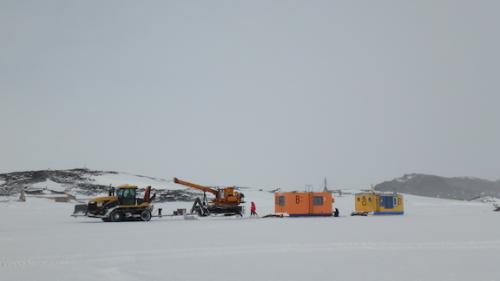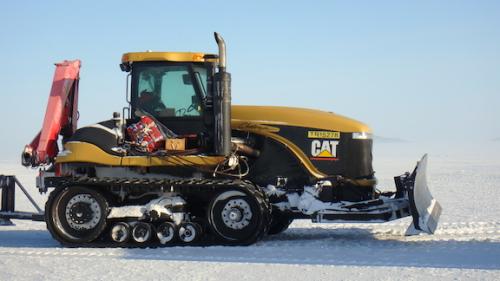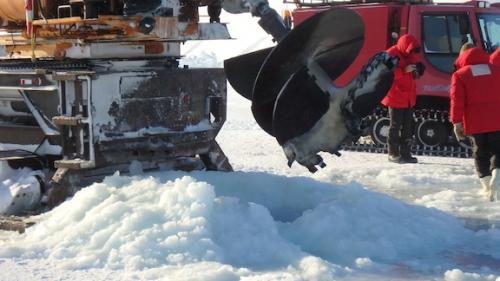 A Challenger pulls an ice drilling rig and two huts in front of Scott's Cape Evans Hut.
A Challenger pulls an ice drilling rig and two huts in front of Scott's Cape Evans Hut.
McMurdo Sound is the section of the Ross Sea between Ross Island - where McMurdo Station is located - and mainland Antarctica. It's where we do the bulk of our diving because the ocean here houses a number of different ecosystems from rocky bottom habitats to soft mud environments to underwater cliffs. Even though all of these are located just a few football field lengths away from Station, getting access to them is quite an operation, requiring the efforts of people and equipment from several different Station departments.
 Challengers are track-equipped tractors capable of all manner of heavy lifting and towing on the sea ice.
Challengers are track-equipped tractors capable of all manner of heavy lifting and towing on the sea ice.
Monday morning found me standing on the sea ice in the sub-zero cold and bluebird bright sunshine beneath Observation Hill, watching a train come rumbling across the ice out of McMurdo Station. The train was in fact a track-equipped Caterpillar tractor called a "Challenger" towing a drilling rig, a bright orange rectangular dive hut, and a sled with several large drill bits. Team Pycno leader Dr. Art Woods had invited me along to help Dive Supervisor Steve Rupp and the McMurdo Fleet Operations drilling team set up two diving shelter huts within site of Station. The drilling team needed a few extra sets of hands to help with some of the odds and ends and I was happy to oblige.
 The drilling rig's 40in/100cm diameter augur takes about 5 minutes to cut through 7ft/2m of sea ice.
The drilling rig's 40in/100cm diameter augur takes about 5 minutes to cut through 7ft/2m of sea ice.
With my back to our PistenBully, I kept well clear as the Challenger train pulled up alongside, stopped, and detached the drill bit sled and the hut. The driver then circled the tractor and rig back around to the sled, attaching the 40in/100cm ice augur to the drilling rig, and pulled up at a spot on the ice that Steve had selected by marking it with a hazard flag. Ten minutes later, a hole had been drilled in the sea ice with the Challenger pushing away the small mountain of slush, snow, and sea ice flakes with its plow. Disconnecting from the rig, the Challenger then backed up to the hut as Art and I strained to lift the hut's heavy steel towing bridle while Steve connected it to the Challenger's towing hitch. Signaling the driver with hand signals, Steve and the drive positioned the hut's cutout floor over the hole in the ice. To prevent cold air from flowing between the building's floor and the ice, and refreezing the hole, the Challenger used its plow to push snow up against the ends of the hut. Hut number 02 was now more or less in business. Art and I climbed inside to fish the rest of the pale-blue slushy sea ice out of the hole using dip nets. Carpenters soon arrived to activate the diesel heaters which keep the hut warm and the hole from refreezing. Art, Steve, and I then followed the Challenger, moving on to drill another hole, repositioning a nearby hut. Making scientific diving safe and reasonably comfortable in Antarctica is laborious and dramatic, and takes the coordination of several different teams to be successful. After fifty or so years of experience, the teams at McMurdo Station are a well oiled machine; I was impressed by the complexity and efficiency of the operation.


Comments